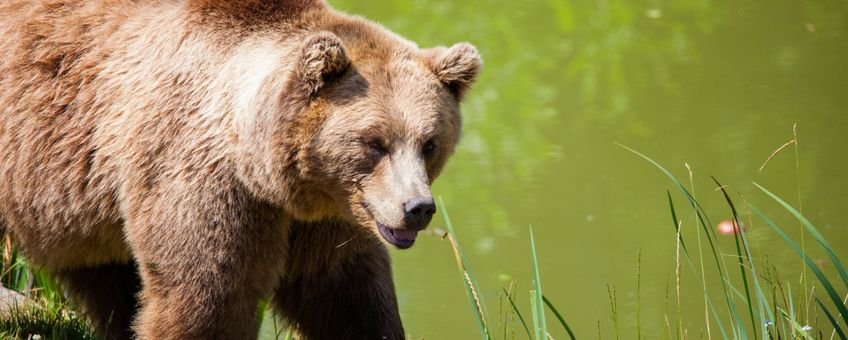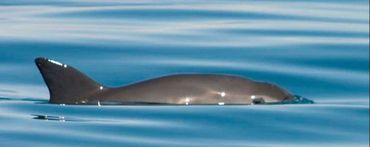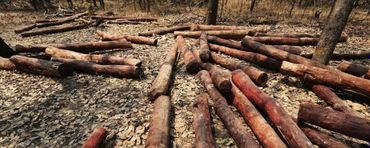
10 Species having a worse Monday than you
I Love Conservation
05-JUL-2017 - A large variety of species in the world is not doing so well. They range from corals to trees to bears. Ten of these species are highlighted in this article.
1. Vaquita
 Why: At any given moment, while Vaquita are just swimming around minding their daily business, they can swim into an illegal fishing net, become entangled and die.
Why: At any given moment, while Vaquita are just swimming around minding their daily business, they can swim into an illegal fishing net, become entangled and die.
At this point, every day is a pretty bad day for the Vaquita. This small porpoise is only found in the Gulf of Mexico, and it is estimated that there are less than 30 of them left.
 Why: At any given moment, while Vaquita are just swimming around minding their daily business, they can swim into an illegal fishing net, become entangled and die.
Why: At any given moment, while Vaquita are just swimming around minding their daily business, they can swim into an illegal fishing net, become entangled and die.
At this point, every day is a pretty bad day for the Vaquita. This small porpoise is only found in the Gulf of Mexico, and it is estimated that there are less than 30 of them left.
Find out more: A daring rescue operation using U.S. military dolphins (yes, military dolphins, you read that correctly) is being planned to rescue the surviving Vaquitas and bring them into an enclosed area where they might hopefully start to recover.
Click here for more.
Find out more: A daring rescue operation using U.S. military dolphins (yes, military dolphins, you read that correctly) is being planned to rescue the surviving Vaquitas and bring them into an enclosed area where they might hopefully start to recover.
Click here for more.
2. Nile Crocodile
 Why: Everywhere it goes, the Nile crocodile risks being snagged by hand, noosed with barbed wire traps or dazzled with a spotlight, entangled in fishing nets, and subdued with a shot to the underbelly.
Why: Everywhere it goes, the Nile crocodile risks being snagged by hand, noosed with barbed wire traps or dazzled with a spotlight, entangled in fishing nets, and subdued with a shot to the underbelly.
In Lake Nasser, Egypt, being a crocodile has become a lot more dangerous in recent years. Since the Tahrir Square upraising of 2011 tourism in the area has markedly fallen, and poaching of Nile crocodiles is now rampant.
Find out more: The Egyptian Ministry of Environment wants to start raising crocodiles on a farm a few miles from Lake Nasser. They’ll take eggs from the lake and harvest a certain number of crocodiles every year for legal sale in skins, hoping to reduce poaching levels.
Click here for more.
3. Mukula Tree
 Why: While just standing around turning sunlight into sugar, as trees do, these slow-growing hardwoods are easy prey for loggers looking to make a quick profit.
Why: While just standing around turning sunlight into sugar, as trees do, these slow-growing hardwoods are easy prey for loggers looking to make a quick profit.
Unique to southern and central Africa, this tree is easily passed off as traditional rosewood – a type of wood highly sought out for upscale furniture in China. Rosewoods have become so rare and threatened, that look-alike trees like the Mukula are now being targeted.
 Why: While just standing around turning sunlight into sugar, as trees do, these slow-growing hardwoods are easy prey for loggers looking to make a quick profit.
Why: While just standing around turning sunlight into sugar, as trees do, these slow-growing hardwoods are easy prey for loggers looking to make a quick profit.
Unique to southern and central Africa, this tree is easily passed off as traditional rosewood – a type of wood highly sought out for upscale furniture in China. Rosewoods have become so rare and threatened, that look-alike trees like the Mukula are now being targeted.
Find out more: Local authorities are trying to curb the trade, and the Democratic Republic of Congo arrested 14 Chinese nationals in May on suspicion of illegal logging and export of Mukula wood. However, any serious effort to moderate Mukula logging will have to come from China.
Click here for more.
4. Little Tern
 Why: While trying to raise a family in a small UK breeding colony, little terns saw 50 of their nests destroyed by vandals using dogs. Only 29 nests remain at the coastal site.
Why: While trying to raise a family in a small UK breeding colony, little terns saw 50 of their nests destroyed by vandals using dogs. Only 29 nests remain at the coastal site.
Little terns are one of the UK's rarest seabirds and are protected by law. The vandalised site, which is one of 20 in the UK, is protected by fences and watched over by wardens during the day. The incident happened over the weekend.
Find out more: The birds arrive in the UK from Africa in April and May. They require a mix of sand and shingle to build their nests and they usually choose beach areas, which are susceptible to attack from natural predators like kestrels and sparrow hawks.
Click here for more.
 Why: While trying to raise a family in a small UK breeding colony, little terns saw 50 of their nests destroyed by vandals using dogs. Only 29 nests remain at the coastal site.
Why: While trying to raise a family in a small UK breeding colony, little terns saw 50 of their nests destroyed by vandals using dogs. Only 29 nests remain at the coastal site.Little terns are one of the UK's rarest seabirds and are protected by law. The vandalised site, which is one of 20 in the UK, is protected by fences and watched over by wardens during the day. The incident happened over the weekend.
Find out more: The birds arrive in the UK from Africa in April and May. They require a mix of sand and shingle to build their nests and they usually choose beach areas, which are susceptible to attack from natural predators like kestrels and sparrow hawks.
Click here for more.
5. Pangolin
 Why: Even though their scaly armor can withstand the bites of large predators such as tigers, they are defenseless against the snares and weapons of poachers, which are waiting for the pangolins when they come out at night to forage for insects.
Why: Even though their scaly armor can withstand the bites of large predators such as tigers, they are defenseless against the snares and weapons of poachers, which are waiting for the pangolins when they come out at night to forage for insects.Each year an estimated 100,000 pangolins are poached and trafficked, driving the species closer to the edge of extinction. All eight subspecies of pangolins are now critically endangered and the animals have been dubbed the “world’s most trafficked mammal.”
Find out more: Last month, customs officials at Kuala Lumpur’s international airport seized two giant hauls of pangolin scales, which had been flown in from Africa. These seizures of scales show that the mass slaughter of African pangolins continues unabated.
Click here for more.
6. Zooplankton
 Why: While just drifting through the ocean near the surface, doing what zooplankton do, they can be blasted away at any moment by seismic blasts, used by petroleum companies to prospect for oil and gas under the ocean floor.
Why: While just drifting through the ocean near the surface, doing what zooplankton do, they can be blasted away at any moment by seismic blasts, used by petroleum companies to prospect for oil and gas under the ocean floor.These blasts are deafening to animals underwater and are already known to have consequences for marine mammals. Zooplankton underpin the health and productivity of global marine ecosystems, and commercial seismic surveys could cause significant disruption to their population levels.
Find out more: Earlier this month, the Trump Administration took steps to allow five energy companies to use seismic air guns to search for oil and gas off the U.S. Atlantic coast.
Click here for more.
7. Monitor Lizard
 Why: Wanting to reproduce is a natural instinct, but being a male monitor lizard in India is risky these days. These large reptiles are being illegally caught, so that their penises can be sold to customers looking for a rare Indian plant called “Hatha Jodi”. The monitor lizard above does not look amused at this prospect.
Why: Wanting to reproduce is a natural instinct, but being a male monitor lizard in India is risky these days. These large reptiles are being illegally caught, so that their penises can be sold to customers looking for a rare Indian plant called “Hatha Jodi”. The monitor lizard above does not look amused at this prospect.The fake Hatha Jodi (i.e., dried lizard penises) are not only being sold in stores in India, but also through major online retailers like Amazon, eBay, Snapdeal and Etsy to customers around the world.
Find out more: All four species of monitor lizards found in India are protected by the Indian Wildlife (Protection) Act 1972, making the trade in these animals illegal. The Bengal and Yellow monitor lizards are also listed under Appendix I of CITES, which bans their global trade.
Click here for more.
8. Giraffe
 Why: In addition to having to cope with the devastating drought and overgrazing of their habitat in northern Kenya, giraffes are now having to cope with a surge in wildlife killings prompted by tensions between herders and rangers over land use.
Why: In addition to having to cope with the devastating drought and overgrazing of their habitat in northern Kenya, giraffes are now having to cope with a surge in wildlife killings prompted by tensions between herders and rangers over land use.In the past 30 years, populations of two East African varieties, the Nubian and reticulated giraffes, have plunged by 97% and 78%, respectively. The biggest threats are rapid human population growth and the influx of herders, along with refugees fleeing regional conflicts.
Find our more: Giraffes are especially vulnerable to population decline since an average female gives birth to only five calves during her lifetime, and only half of those normally survive – meaning that the species has zero population growth.
Click here for more.
9. Coral
 Why: Things have been getting hot for corals around the world, and not in a good way. When temperatures get too high, corals experience bleaching - they lose their algae and begin to starve - which is not a great way to start the week. Reefs could be gone in 30 years unless global warming is curbed.
Why: Things have been getting hot for corals around the world, and not in a good way. When temperatures get too high, corals experience bleaching - they lose their algae and begin to starve - which is not a great way to start the week. Reefs could be gone in 30 years unless global warming is curbed.Many reef areas will experience twice-per-decade severe bleaching events by 2040—a frequency that will rapidly kill most corals present and prevent successful reproduction necessary for their recovery.
Find out more: Reefs occupy less than 1% of the ocean floor, but provide habitat for a million species, including a fourth of the world’s fish. They also protect coastlines against erosion from tropical storms and act as a barrier to sea-level rise.
Click here for more.
10. Grizzly Bear
 Why: After 42 years of enjoying the protection afforded by being on the endangered species list, Yellowstone grizzly bears are about to have a lot more to worry about, since they are close to losing their protected status.
Why: After 42 years of enjoying the protection afforded by being on the endangered species list, Yellowstone grizzly bears are about to have a lot more to worry about, since they are close to losing their protected status.That means fewer restrictions, and could mean a hunting season being open for these bears outside of Yellowstone national park. This action will not affect the protected status of other grizzly bear populations in other U.S. states.
Find out more: Conservation organisations and Native American tribes are contesting the decision, arguing that climate change has made ecological conditions in Yellowstone uncertain, and could endanger the bear in the future.
Click here for more.
Text: I F Love Conservation
Photos: Tom Jefferson, VIVA Vaquita, Pexels.com; Tim Muttoo; Lu Guang, Greenpeace; J.J. Harrison; Christian Boix; Carlos Delgado
Photos: Tom Jefferson, VIVA Vaquita, Pexels.com; Tim Muttoo; Lu Guang, Greenpeace; J.J. Harrison; Christian Boix; Carlos Delgado
